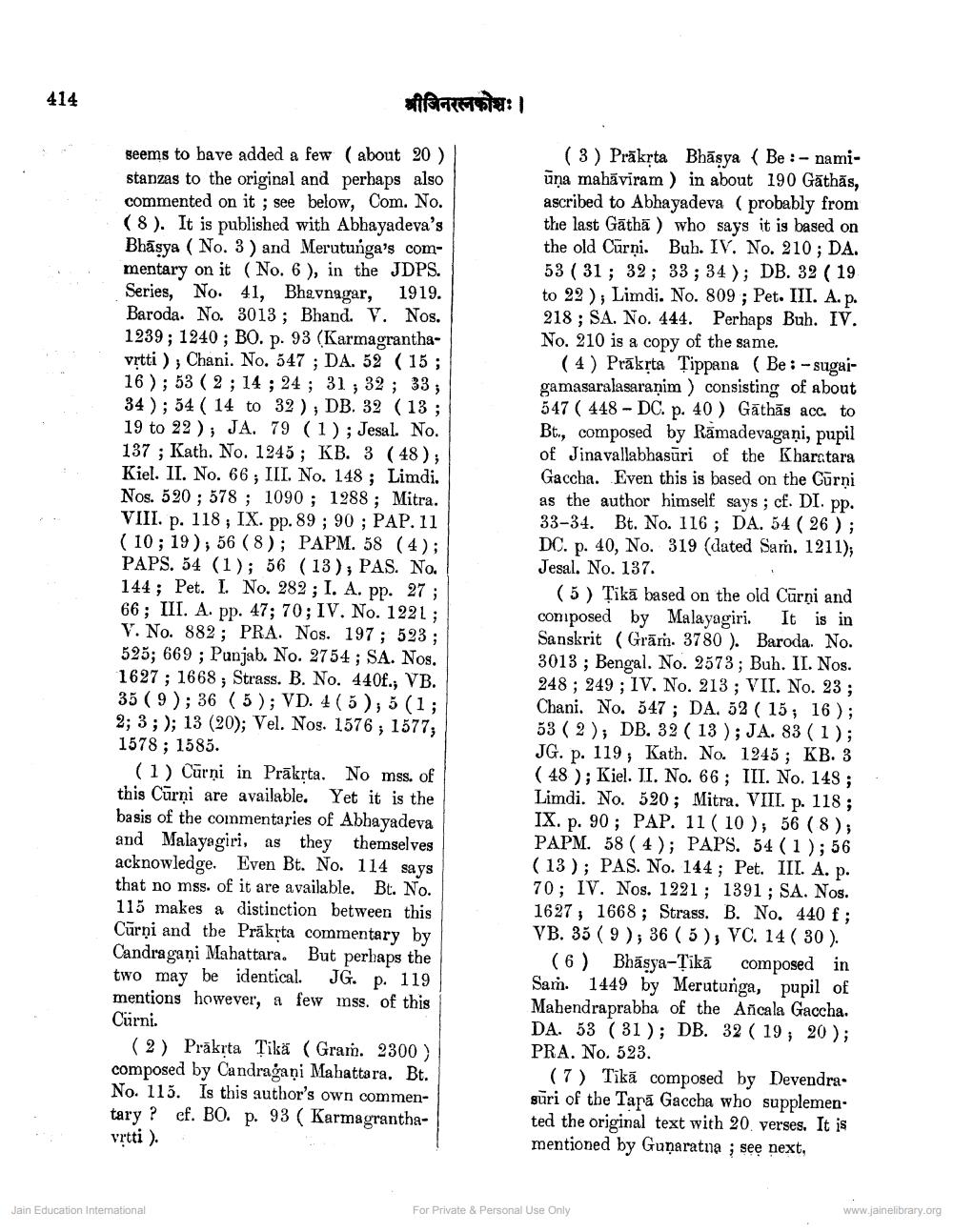________________
414
श्रीजिनरलकोशः।
seems to bave added a few (about 20 ) stanzas to the original and perhaps also commented on it ; see below, Com. No. (8). It is published with Abhayadeva's Bhāsya ( No. 3 ) and Merutunga's commentary on it (No. 6), in the JDPS. Series, No. 41, Bhavnagar, 1919. Baroda. No. 3013; Bhand. V. Nos. 1239; 1240; BO. p. 93 (Karmagranthavrtti ); Chani. No. 547 ; DA. 52 (15; 16 ); 53 ( 2 ; 14 ; 24 ; 31; 32; 33; 34 ); 54 ( 14 to 32 ), DB. 32 (13 ; 19 to 22); JA. 79 (1); Jesal. No. 137 ; Kath. No. 1245; KB. 3 (48); Kiel. II. No. 66; III. No. 148 ; Limdi. Nos. 520 ; 578 ; 1090; 1288; Mitra. VIII. p. 118 ; IX. pp. 89 ; 90 ; PAP. 11 (10; 19); 56 (8); PAPM. 58 (4); PAPS. 54 (1); 56 (13); PAS. No. 144 ; Pet. I. No. 282; I. A. pp. 27; 66; III. A. pp. 47; 70; IV. No. 1221; V. No. 882; PRA. Nos. 197; 523 ; 525; 669 ; Punjab. No. 2754 ; SA. Nos. 1627; 1668 ; Strass. B. No. 440f.; VB. 35 ( 9 ); 36 ( 5 ); VD. 4 (5); 5 (1; 2; 3; ); 13 (20); Vel. Nos. 1576; 1577; 1578; 1585.
(1) Cūrni in Prākrta. No mss. of this Cūrņi are available. Yet it is the basis of the commentaries of Abhayadeva and Malayagiri, as they themselves acknowledge. Even Bt. No. 114 says that no mss. of it are available. Bt. No. 115 makes a distinction between this Cūrni and the Prākrta commentary by Candragani Mahattara. But perhaps the two may be identical. JG. p. 119 mentions however, a few mss. of this Cürni.
(2) Prākrta Tikä (Gram. 2300) composed by Candrağaņi Mahattara. Bt. No. 115. Is this author's own commentary ? ef. BO. p. 93 ( Karmagranthavitti).
(3) Prākrta Bhāsya (Be :- namiuna mahāviram ) in about 190 Găthăs, ascribed to Abhayadeva (probably from the last Gāthā ) who says it is based on the old Curņi. Buh. IV. No. 210; DA. 53 ( 31 ; 32; 33; 34); DB. 32 ( 19 to 22 ), Limdi. No. 809 ; Pet. III. A. p. 218; SA. No. 444. Perhaps Buh. IV. No. 210 is a copy of the same.
(4) Prākrta Tippana ( Be : - sugaigamasaralasaranim ) consisting of about 547 ( 448 - DC. p. 40 ) Gātās acc. to Bt., composed by Rāmadevagani, pupil of Jinavallabhasuri of the Kharatara Gaccha. Even this is based on the Cūrni as the author himself says ; cf. DI. pp. 33-34. Bt. No. 116; DA. 54 ( 26 ) ; DC. p. 40, No. 319 (dated Sam. 1211); Jesal. No. 137.
(5) Țikā based on the old Cūrņi and composed by Malayagiri. It is in Sanskrit (Grām. 3780 ). Baroda. No. 3013; Bengal. No. 2573; Buh. II. Nos. 248 ; 249 ; IV. No. 213; VII. No. 23; Chani. No. 547 ; DA, 52 (15; 16 ); 53 (2); DB. 32 ( 13 ); JA. 83 (1); JG. p. 119, Kath. No. 1245; KB. 3 ( 48 ); Kiel. JI. No. 66; III. No. 148; Limdi. No. 520; Mitra. VIII. p. 118; IX. p. 90 ; PAP. 11 ( 10 ); 56 ( 8 ); PAPM. 58 ( 4 ); PAPS. 54 (1); 56 ( 13 ); PAS. No. 144; Pet. III. A. p. 70; IV. Nos. 1221; 1391 ; SA. Nos. 1627; 1668; Strass. B. No. 440 f; VB. 35 ( 9 ); 36 ( 5 ), VC. 14 ( 30 ).
(6) Bhāsya-Tikā composed in Sam. 1449 by Merutunga, pupil of Mahendraprabba of the Añcala Gaccha. DA. 53 ( 31 ); DB. 32 ( 19; 20); PRA. No. 523.
(7) Tikā composed by Devendraguri of the Tarā Gaccha who supplemented the original text with 20. verses. It is mentioned by Gunaratna ; see next,
Jain Education International
For Private & Personal Use Only
www.jainelibrary.org




